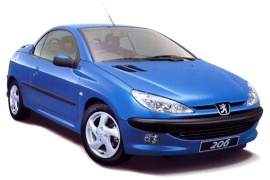PEUGEOT 206 CC Models/Series Timeline, Specifications & Photos
First production year: 2001
Engines: Gasoline, Diesel
Body style: Convertible (spider/spyder, cabrio/cabriolet, drop/open/soft top)
Peugeot is the automaker that produced the first car with a retractable hard top, and the 2001 206 CC continued that forgotten history lesson.
Before WWII, in 1935, Peugeot launched the first production car fitted with a retractable hard top: the 402 Eclipse. While it was an innovative feature, that model didn't enjoy great success at that time due to its high price. Still, in the mid-90s, after Mitsubishi made the 3000 GT Spyder and Mercedes-Benz made the SLK, the French marque pushed its design department to create such a vehicle.
In 2000, at the Geneva Motor Show, Peugeot unveiled the 2-Heart-6 concept car that previewed the open-top version of the 206. While many people considered that the automaker wouldn't launch that version in production, Peugeot did it. In September of that year, on its home ground, the French automaker revealed the 206 CC, where the initials stood for Coupe-Cabriolet.
With the 206 CC, the French automaker attracted many customers from other car segments. The car's front fascia resembled the rest of the 206 range, but that was the only actual connection with them. Its organic-shaped headlights were inspired by the eyes of a feline. They flanked the slim upper grille that was crossed by one slat and supported the automaker's badge.
On the lower side of the bumper, the car manufacturer added a secondary, broader grille that sported a mesh styling. ]A lower black lip mounted underneath the apron enhanced the vehicle's sporty look. From its profile, the little 206 CC unveiled its curved and raked windshield supported by thick A-pillars. Behind the short doors, Peugeot created a specific shape for the rear fenders to match the retractable hood mechanism.
Despite the vehicle's small size, the automaker managed to create a 2+2 seat layout for the 206 CC. Since the car targeted customers who desired a chic-looking coupe-convertible fit for the urban environment, it offered a leather-wrapped interior with sports seats at the front. The rear bench seat was divided, and there was almost no legroom for anyone to sit there, at least not for a long time.
With its four-dial instrument cluster adorned by chromed trims, the automaker matched the look of more expensive vehicles on the market. In addition, the leather three-spoke steering wheel looked premium. Customers could get a premium sound system mounted above the HVAC controls on the center stack.
Peugeot placed a button between the front seats on the center console to cover or uncover the car. The car had to be stopped, and then the whole ballet could begin. The entire process of lowering the windows, covering or uncovering the retractable hood, and closing the trunk took about 20 seconds.
Under the hood, Peugeot installed a choice of three engines ranging between 109 PS (107 hp) and 140 PS (138 hp) paired with either a five-speed manual or a four-speed automatic.
